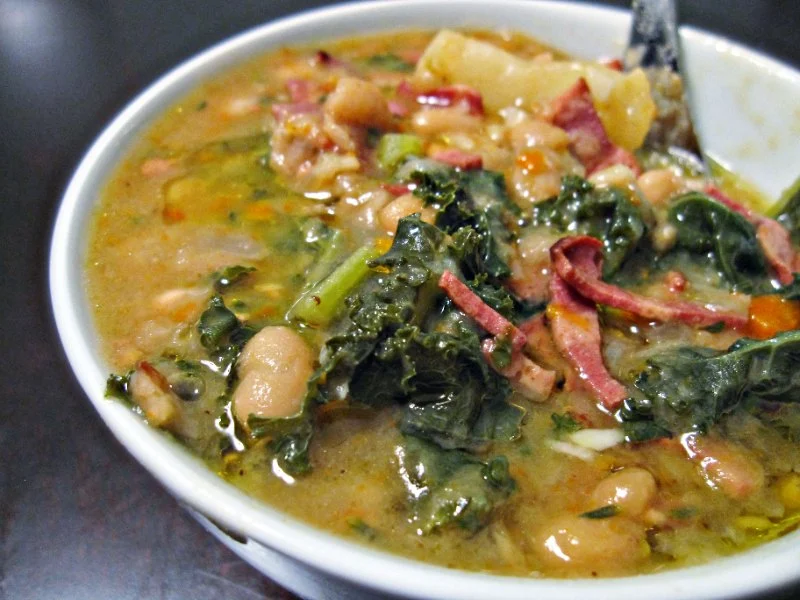
How to Make Spanish Caldo Gallego: Hearty Galician Soup
- 1- What is Caldo Gallego?
- 2- Key Ingredients for Caldo Gallego
- 3- Step-by-Step Guide to Making Caldo Gallego
- 4- Tips for Perfecting Your Caldo Gallego
- 5- Why Caldo Gallego is a Favorite in Galicia
1. What is Caldo Gallego?
Caldo Gallego is a traditional Spanish soup originating from Galicia, a region in the northwest of Spain. Known for its hearty and flavorful profile, this dish combines simple yet nourishing ingredients such as greens, potatoes, beans, and pork. It's often enjoyed as a comforting meal during the cold months, providing warmth and satisfaction. The name "caldo" translates to "broth," and "gallego" refers to the region where it originated, which is known for its unique culinary traditions.
While the dish has been enjoyed for centuries, Caldo Gallego continues to be a symbol of Galician hospitality. It’s typically served as a starter during large family meals or festive occasions, but its hearty nature makes it a satisfying meal on its own.
2. Key Ingredients for Caldo Gallego
To make a true Caldo Gallego, you'll need a few key ingredients that give the soup its distinctive taste and texture. The traditional recipe uses the following components:
1. Turnip Greens (or Galician Broth Greens)
The heart of the dish is the turnip greens, also known as "grelo." These greens give the soup its earthy flavor and are a key ingredient that distinguishes Caldo Gallego from other soups. If turnip greens are hard to find, spinach or collard greens can be used as a substitute.
2. Potatoes
Potatoes are a staple in many Spanish dishes, and Caldo Gallego is no exception. They provide a creamy base for the soup and help thicken the broth, making it more satisfying.
3. Beans
White beans, such as the classic Spanish "judiones," add texture and richness to the soup. They are typically cooked until tender, absorbing the flavors of the broth.
4. Pork (Pork Bones, Chorizo, or Bacon)
Pork is often used in Caldo Gallego for its deep, savory flavor. Traditional recipes may call for pork bones or smoked chorizo, adding a smoky richness to the broth. Some variations may also include ham or bacon, depending on the region and personal preference.
5. Olive Oil
Olive oil, a key element in Spanish cooking, is used to sauté vegetables and create the base for the broth. Its fruity, nutty flavor enhances the soup's overall taste.
3. Step-by-Step Guide to Making Caldo Gallego
Making Caldo Gallego at home is a rewarding experience, and while it requires a few ingredients and some patience, the end result is a delicious, hearty soup. Here's a simple, step-by-step guide to help you make this Galician classic.
Step 1: Prepare the Ingredients
Begin by washing the turnip greens (or your substitute greens) thoroughly. Peel and chop the potatoes into bite-sized chunks. Rinse and soak the white beans if you're using dried beans. If using chorizo or pork bones, cut the chorizo into slices or break the bones into smaller pieces for better flavor extraction.
Step 2: Sauté the Vegetables
In a large pot, heat some olive oil over medium heat. Add the chorizo or pork (if using) and sauté until browned. Then, add onions, garlic, and a pinch of salt, stirring occasionally until they soften and become fragrant.
Step 3: Add the Potatoes and Beans
Once the vegetables have softened, add the chopped potatoes and beans to the pot. Pour in enough water to cover the ingredients by at least an inch or two. Bring the mixture to a boil and then reduce the heat to a simmer. Let it cook for about 30–40 minutes until the potatoes and beans are tender.
Step 4: Add the Turnip Greens
Once the potatoes and beans are cooked, add the turnip greens (or your substitute greens) to the pot. Let the soup simmer for another 10–15 minutes, until the greens are tender and well incorporated into the broth.
Step 5: Season and Serve
Taste the soup and adjust the seasoning with salt, pepper, or a dash of paprika for a little kick. Once you're satisfied with the flavor, remove the pot from the heat and let it rest for a few minutes before serving.
Serve your Caldo Gallego hot, preferably with a slice of rustic bread for dipping. It's a perfect dish for family gatherings or as a comforting meal on a chilly evening.
4. Tips for Perfecting Your Caldo Gallego
To take your Caldo Gallego to the next level, here are some helpful tips:
1. Use Quality Chorizo
The chorizo plays a crucial role in the flavor profile of Caldo Gallego. Make sure to use a high-quality Spanish chorizo for an authentic taste. If you can, opt for smoked chorizo for that extra depth of flavor.
2. Let the Soup Rest
As with many soups and stews, Caldo Gallego often tastes even better the next day. Letting the soup rest for a few hours or overnight allows the flavors to meld and deepen, making it even more delicious when reheated.
3. Experiment with Greens
While turnip greens are the traditional choice, don’t hesitate to experiment with other greens. Collard greens or spinach can work as good substitutes if turnip greens are unavailable.
5. Why Caldo Gallego is a Favorite in Galicia
Caldo Gallego is a beloved dish in Galicia, where it has been passed down through generations. Its hearty and nourishing qualities make it perfect for the cool, rainy weather that is common in the region. The soup’s balance of savory pork, earthy greens, and comforting potatoes makes it a staple for family gatherings, festivals, and special occasions.
Beyond its comforting taste, Caldo Gallego also holds cultural significance. It embodies the spirit of Galician hospitality, where sharing a warm bowl of soup is a symbol of community and togetherness. For many Galicians, this dish connects them to their roots, providing a sense of tradition and pride.
Whether enjoyed at a festive celebration or as a simple home-cooked meal, Caldo Gallego remains a treasured dish in the hearts of many, bringing warmth and comfort to all who partake.









 Chinchorro Boricua0.0 (0 reviews)
Chinchorro Boricua0.0 (0 reviews) Vaca4.0 (885 reviews)
Vaca4.0 (885 reviews) Barcelona Wine Bar4.0 (1640 reviews)
Barcelona Wine Bar4.0 (1640 reviews) Gypsy Kitchen4.0 (3913 reviews)
Gypsy Kitchen4.0 (3913 reviews) Elizabeth Bar and Grill4.0 (31 reviews)
Elizabeth Bar and Grill4.0 (31 reviews) Telefèric Barcelona Palo Alto4.0 (1741 reviews)
Telefèric Barcelona Palo Alto4.0 (1741 reviews) The Best Spanish Restaurants in New Orleans for Mediterranean Cuisine
The Best Spanish Restaurants in New Orleans for Mediterranean Cuisine The Best Spanish Restaurants in Tampa for Tapas, Paella, and Mediterranean Cuisine
The Best Spanish Restaurants in Tampa for Tapas, Paella, and Mediterranean Cuisine The Best Spanish Food Markets in Alicante for Seasonal Fresh Produce
The Best Spanish Food Markets in Alicante for Seasonal Fresh Produce How to Make Spanish Migas con Chorizo y Huevos: Traditional Bread, Sausage, and Egg Dish
How to Make Spanish Migas con Chorizo y Huevos: Traditional Bread, Sausage, and Egg Dish How to Make Spanish Tarta de Almendra y Limón: A Delicious Almond and Lemon Cake Recipe
How to Make Spanish Tarta de Almendra y Limón: A Delicious Almond and Lemon Cake Recipe How to Make Spanish Calamares a la Andaluza con Limón: Andalusian Squid with Lemon Recipe
How to Make Spanish Calamares a la Andaluza con Limón: Andalusian Squid with Lemon Recipe